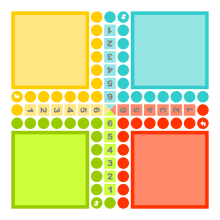Jeu des petits chevaux
The Jeu des petits chevaux (French: game of small horses , in short: Petits chevaux ), or Jeu de dada , is a simple board game that is very well known in France. There it has about the same level of awareness as Mensch ärgere dich nicht in Germany or Haste mit Weile in Switzerland. It is played with colored horses that look like the knights at chess.
Two, three or four players each take two to four of the horse-shaped game pieces and place them in the “racing stable” (starting positions). A beaten horse must be returned to the racing stable. It is beaten by an opposing pawn moving onto the field.
The playing pieces move alternately in a clockwise direction. At the end of the racetrack, which consists of 52 fields, the horses must be drawn with an exact throw into the target field with, depending on the version, five or six entry fields. If you can't pull, you have to sit out.
history
The Jeu des petits chevaux has its origins in the Indian game Pachisi , just as it is similar to the games Parcheesi and Ludo - all board games with a cross-shaped arrangement.
Pachisi appeared in the United States in the mid-19th century, before Parcheesi. The British game Ludo first appeared in England at the end of the 19th century.
In the Belle Époque , Ludo was modified into a French version of Jeu de l'Eden . Likewise, the game Mensch ärgere Dich nicht appeared under the French title “T'en fais pas”.
The game Jeu des petits chevaux probably first appeared in France around 1936. It differs from the previous games in the use of the game pieces in that they have to be pulled into the middle with the exact number of throws. In addition, the game board has no safe fields. It was made by Manufrance and was sold through the department stores.

